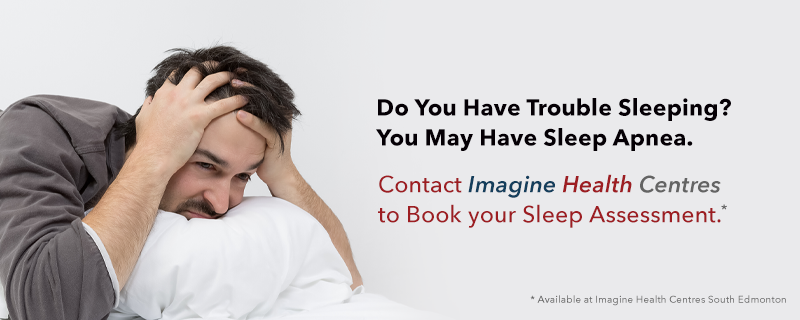What Is Sleep Apnea?
Sleep apnea is a serious disorder that causes your breathing to stop repeatedly while you sleep.
These breathing pauses or “apneas” usually last 10 to 30 seconds and can happen many times throughout the night. The most common type of sleep apnea is obstructive sleep apnea, which happens when the upper airway gets blocked during sleep. Often, the blockage happens when the soft tissue in the back of the throat collapses and closes during sleep. Relaxed throat muscles, a narrow airway, a large tongue or extra fatty tissue in the throat can also block the airway. Central apnea and mixed apnea are other types of sleep apnea, but are rarer.
People with obstructive sleep apnea can stop breathing dozens or hundreds of times each night leading to sleep disruption and low levels of oxygen.
Contact Imagine Health Centres to book a consult with one of our physicians to arrange a sleep assessment: South Edmonton – (780) 468-5999
Health Risks Associated with Obstructive Sleep Apnea (OSA)
- Daytime sleepiness due to lack of proper sleep
- Lack of concentration
- Type II Diabetes: 60% in patients with OSA
- Irritability
- Depression: 58% in patients with OSA
- High Blood Pressure/Hypertension: 45% in patients with OSA
- Obesity: 60% to 90% of OSA patients are considered obese
- Lack of libido and sexual dysfunction in middle aged men
- Chronic Obstructive Pulmonary Disease (COPD): 10% to 15% have OSA
- Heart disease: 38% in patients with OSA
- Congestive Heart Failure: 50% to 70% in patients with OSA
- Arrhythmia
- Stroke
- Patients with OSA are at high risk for cardioembolic stroke (71.9%)
- Premature death
What is Continuous Positive Airway Pressure (CPAP)
A CPAP machine supplies a constant and steady air pressure to keep the airways continuously open. The machine controls the airflow through a tube that carries the air from the machine to you. CPAP is applied through a mask that is placed in or over the nose and may include the mouth in certain patients. The air that CPAP delivers is heated and humidified ‘room air’ that uses a filter to keep dust, particles, and debris out.
There are three important conditions for success: (1) the appropriate pressure, (2) a fitted, comfortable mask, and arguably the most important (3) a positive attitude.
CPAP pressure is decided with professional advice and feedback from your health care provider.
The masks come in different options:
-
- A “nasal pillow mask” that features nasal prongs (called pillows) that fits inside the nose
- This mask is widely regarded as the most comfortable and most effective and the primary choice of mask with Integrated Sleep Group.
- A nasal mask that seals over your nose
- A “nasal pillow mask” that features nasal prongs (called pillows) that fits inside the nose
-
- A full-face mask, which covers your mouth and nose.
If the mask is sealed so that the air pressure from the tube stays constant and does not leak/escape, the CPAP will do what it is designed to do.
The additional pressure provided by the CPAP will support the inhalation and will overcome the obstruction resulting in a normal breathing pattern.
Book a consult with one of our Imagine Health Centres Physicians to arrange your Sleep assessment – (780) 468-5999

